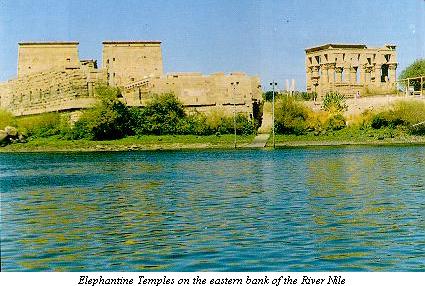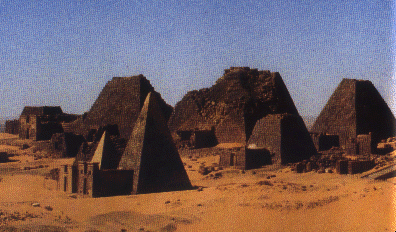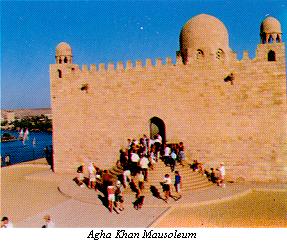

From Late Antiquity and into the early Middle Ages, Upper and Lower Nubia formed three independent kingdoms, Nubadia (called Nubia in Arabic) between the First and Third Cataracts, Makuria between the Third and Fifth Cataracts, and Alodia (called Alwa in Arabic) above the Fifth Cataract. These kingdoms converted to Christianity around the sixth century AD, long after Egypt had become Christian. However, they maintained that faith centuries after Egypt had succumbed to the forces of Islam. These three nations were not always on peaceful terms with each other. However, it was probably as early as the seventh century AD that Nubadia and Makuria united to form a single federated kingdom which was to last some six hundred years under the King of Makuria. Despite the union, each of the two kingdoms always kept their separate identities. This united kingdom was weakened in the late thirteenth century by a series of attacks on Nubia by Mamelukes from Egypt, who ultimately claimed--apparently in name only-- suzerainty over Lower Nubia. In the fourteenth century, Makuria was overrun by nomadic Arab invaders from the southeast who established a short-lived Muslim kingdom there. This state ultimately degenerated into a series of warring principalities without any royal authority and the population reduced to the level of bedouin. Nubadia and its client- state, the Kingdom of Dotawo survived for more than a century thereafter, until disappearing in the unrecorded dwindling of cultural identity. In AD 1550 the Ottoman Turks annexed a disunited Lower Nubia to their great Near Eastern empire. Nubian independence, national identity, and Christianity disappeared without leaving any record.

Nubia is an area of scholarship that was largely overlooked in favor of its splendid neighbor, Egypt. Past finds in the area were attributed to Egypt; current excavation of the area is impossible because of Egypt's construction of the High Aswan Dam. However, renewed interest in Africa - brought on largely by Afrocentric scholars such as Cheikn Anta Diop - has resulted in a proliferation of scholarly work on ancient Nubia.
Much of the scholarly work up to this point is dealing with the massive archeological digs that occurred just prior to the building of the High Aswan Dam. As a result of this work, the amount of available information on Nubia has increased immeasurably. Evidence has emerged that shows a people who, after decades of colonization by the Egyptians, rose above and established themselves as a force to be dealt with in Africa. Nubians developed a culture and people distinctly different from the Egyptians.
After preliminary investigation into the area of ancient Nubia, a striking contrast emerged. The Nubians has an unusually high number of ruling queens, especially during the golden age of the Meroitic Kingdom (1). Although ruling queens, in themselves, may not be unusual, the portrayal of Nubian queen is exceptional. A panel on display at the exhibit "Nubia: Egypt's Rival in Africa" showed the queen smiting her enemies. This type of representation has no equivalent in either Egyptian or Western Art (2). This unusual find has led to research in the role of the women in Nubian society, both past and present. The result has been a surprising contrast between the docile Nubian woman of today and the warrior queen of ancient times.
Nubia would be a five-hundred mile long stretch of land along the Nile river that is one-third in modern day Egypt and two-thirds in the modern day Sudan (3). The kingdom of Ancient Nubia began a bit before the first cataract and extended past the sixth cataract to Khartoum (4). As with the Egyptians, the fertile Nile valley gave rise to the civilization of Nubia.
The first Nubian age spanned from 3100 to 1000 B.C. This Bronze Age contained three cultures: A-Group, C-Group, and the Kerma culture (5). The latter of the three, Kerma, existed in the Upper Nile. These people developed a strong trading culture that traded to both Egypt and the Eastern Mediterranean (6). During this period, the Egyptians called this area "Kush." Kush was the general term for Upper Nubia and was considered to be a province of Nubia (7). The A-Group and C-Group cultures are those that existed in the Lower Nile. For most of the early part of their history, these cultures were dominated by Egypt.
The period of 1550 B.C. to 1100 B.C. marked the colonization of Nubia by Egypt. By the Eighteenth Dynasty, Egypt had control over Lower and Upper Nubia, while Southern Nubia remained independent (8). The Egyptians began to call "Lower Nubia the land of Wawat and Upper Nubia refers to the entire regionbetween the first and fifth cataracts. Therefore, any reference to Kush,considered to be a Nubian province, would be considered part of Nubia in general. Nubia the land of Kush" (9). This colonization resulted in the disappearance of a particular Nubian C-Group; these peoples began to adopt Egyptian culture in favor of their own (10). This colonization was especially bitter as it occurred during the reign of Tutankhamen who was the son of a Nubian woman (11).
Soon after the Twentieth Dynasty in Egypt, the Egyptians lost control over
Nubia and the land was plunged into a dark age. Around 900 B.C., evidence
of a Nubian monarchy begins to emerge. Since this monarchy begins in
Upper Nubia, it was often known as the Kingdom of Kush (12). These early
rulers were buried in tumulus - a distinctly Nubian tradition. This
ceremony has led many to believe that the Kushite Kings were of Nubian
ancestry (13). By 770 B.C., these kings were extending their rule to the
North. In Nubian history, the period is commonly called the Napatan
Period (named for the royal capital of the time). Soon, Nubians "paid
back the insult by subjugating the 'all powerful' nation" of Egypt to
Nubian control. (14). The Kings now wore the crown of the double cobra -
signifying the unity of both Egypt and Nubia (15).
Soon after, the X-Group Period began in Nubia. This period was brusquely
ended in 540 A.D. with the onslaught of Christianity. Missionary
activities continued in the area until approximately A.D. 1550. After
this time, the Nubian empire was completely dismantled. The Nubian people
were left scattered throughout the fertile Nile valley; two-thirds within
Egypt, one-third within the Sudan. With the construction of the High Dam
at Aswan in the early 1960's, these peoples were displaced and moved
elsewhere in Egypt (18). Although a systematic archeological
investigation of the area was conducted, some of the questions that swirl
around the kingdom of Nubia are forever lost as Nubia again becomes
subject to Egyptian control.
Although Sudan had remained the main homeland of Nubians through their long history, their descendents today live in Sudan and Egypt as well. However the majority of Nubians of today are Sudanese. With only a population of slightly above 300,000 they are a minority in both countries. Nevertheless being African descendents they resemble other Sudanese people rather than Egyptians.
Respectively and with such resemblance and an inherited background of a great civilisation and culture the Sudanese Nubian minority show a great deal of presence among other Sudanese. Their remarkable and positive contribution to well-being of Sudan is unequal and mismatches the reality of being a very small minority. In Egypt they are a minority of the overall minority Nubians of Africa and show less distinctive presence there.This is mainly due to the fact that Egyptians overwhelmingly promote their old Egyptian civilisation which has got a lot of international recognition as well as been a arrival to the Nubian civilisation.
Nubian in both Sudan and Egypt had suffered a lot from intentional overlooking to their history and culture as well as displacement, relocation due to flooding and inundation of their homeland by dams constructed south of Egypt. During this century the Nubian homeland had been inundated three times, however the 1960 Nubian Exodus remains as the most painful to all Nubians.
Following the construction of Aswan High dam in 1960 the land of Nubia between Aswan in Egypt and the 4th cataract in Sudan (main area of Nubians) was the subject of flooding and inundation. Nubians were displaced and relocated in other areas in both Sudan and Egypt. Great Nubian monuments and historical sites were drowned and lost for good. Nubians were dispersed. However the Nubians with their inherited values and traditions had shown a great deal of tolerance and willingness to overcome such difficulties and remain very loyal to their common land (Sudan and Egypt).
The influx of Arabs to Egypt and Sudan had contributed to the suppression of the Nubian identity following the collapse of the last Nubian kingdom in 1900. A major part of Nubian were totally arabized or claimed to be arabs (Jaa'leen-the majority of Northern Sudanese- and some Donglawes in Sudan, Kenuz and Koreskos in Egypt). However all Nubian were converted to Islam and Arabic language became their main media of communication in addition to their indigenous old Nubian language.The unique characteristic of Nubian is shown in their culture (dress,dances,traditions and music) as well as their indigenous language which is the common feature of all Nubian.
The distinguished and soft rhythms of the Nubian music and songs are borrowed by other ethnical groups in Sudan. In Egypt these rhythms are commonly used by some Egyptian-Nubian who sing in arabic. With its very distinctive chantings and intonation the Nubian songs and music has a noticeable acclaimation and acceptence among non-Nubian Sudanese and Egyptians..
Upon close examination of the history and culture of Nubia, it becomes
apparent that women played an important role. Unlike the rest of the
world at the time, women in Nubia exercised significant control. In the
Nubian valley, worship of the queen of all goddesses, Isis, was paramount.
>From the capital of Meroe, warrior queens fought for the interests of the
Nubian/Kushite empire. Throughout history, women were portrayed in Nubian
art as the bearers of the offspring of the gods. Today, Nubian women have
a much different experience. Nevertheless, Nubian women fulfill a
demanding and unique series of roles.
Throughout Egypt and Nubia, the cult of Isis had a tremendous and devoted
following. Isis was not only the Egyptian goddess of magical powers; she
was the representation of the queen mother. In the most famous fable of
the period, Isis roams the world in search of the corpse of her husband
Osiris. She returns Osiris to his rightful resting place, only to have
Osiris' evil brother Set cut him to pieces and scatter him throughout the
land. Isis then takes her son Horus and sets out to find every piece of
the corpse so she may tenderly bury it in the hopes that she can resurrect
him again. She is successful, and Osiris becomes the god of the
underworld.
Although Isis, Osiris, and Horus are then established as a trinity, Isis
immediately became the most popular of the three (19). This can be
partially attributed to her role as the devoted, untiring, nurturer of the
land and culture of Egypt and Nubia.
The Cult of Isis was the strongest religion in Nubia (20). In contrast,
the Egyptians worshipped Ra (Re) in larger numbers. Ra was the god of the
sun, and distinctly male at that. The worship of Isis began with the
Meroitic period and extended into X-Group. Many Nubian rulers of the time
were pictured with Isis on their crowns. This was considered a homage to
her role as the "Queen of All Gods, Goddesses and Women" (21). Since the
ruler was considered to be born of the gods, it was only natural that the
mother should be paid such a tribute. Another example of this type of
tribute is the amulet of Isis suckling a Queen. With the exception of the
Nubian/Kushite Empire, Isis was never shown with a queen (22). This
tribute was always given to a male ruler, never a female. However, since
both Isis and the Queens played such important roles in Nubia, the
exception was made.
Another example of the reverence of Isis was the "co-sponsorship" by Egypt
and Nubia of her temple at Philae (23). Here her cult continued,
populated largely by Nubians, until the sixth century A.D. (24).
Perhaps as a result of the strong influence of women figures in religion,
Nubia and its Kushite rulers gave way to a number of strong queens during
its history. Ten sovereign ruling queens are recognized from the period.
Additionally, six other queens who ruled with their husbands were
considered significant to the history of Nubia (25). Many of these rulers
were immortalized in statuary; it was unheard of for non-ruling queens or
princesses to be immortalized in art (26). These queens were often
portrayed as being very rounded; this portrayal was all part of the
queen-mother model (27). These queens were called both gore, meaning
ruler, and kandake, meaning queen mother (28). This last term has been
corrupted to the English form Candace. Subsequently, there has been much
confusion; some Western scholars muddle the actions of queens together
under the general name.
The emergence of the queen as a viable player in the politics of the day
has its roots in the earliest Kushite tradition. Kushite rulers married
and then passed more royal power into the hands of the queen (29). The
perfect example of the expanded powers of the queen is Kushite Queen
Amanirenas. In 24 B.C., she was threatened by the Roman Empire. Egypt
was under the subjugation of Rome and the frontier of the Kushite/Nubian
empire was seventy miles south of Syene (Assuan) (30). The Nubians were
constantly raiding their Egyptian neighbors. On one of these journeys,
the Kandace Amanirenas went along. When confronted, she led her armies
into battle and defeated three Roman cohorts. In addition, the Kandace
defaced a statue of Emperor Augustus Ceasar; bringing the head back to
Nubia as a prize. This head was buried in the doorway of an important
building as a final act of disrespect (31).
During battle, the Kandace lost an eye; but this only made her more
courageous (32). "One Eyed Candace," as then Roman governor Gaius
Petronius referred to her, was chased by the Romans far into her own
territory to Pselkis (Dakka) (33). After a three day truce, the Romans
struck back. The Kandace and her armies made another stand at Primis
(Kasr/Brim), but there were soundly defeated. Although Rome destroyed the
religious capital of Napata, there was still the danger of retaliation by
the Kandace's armies. At this point, the leaders negotiated a treaty that
she was to break in a few years (34). A historian of the period remarked
"This Queen had courage above her sex" (35). On a broader level, this is
a telling example of a European civilization unprepared for the "fierce,
unyielding resistance of a queen whose determined struggle symbolized the
national pride of a people who, until then, had commanded others" (36).
Furthermore, these queens of the Nubian/Kushite Empire were given the
special distinction of assuming a priestly role in the divine succession
of kings (37). In other societies of the period, the divine right of the
king passed from god to ruler, there was no room for a maternal figure.
However, Nubian queens are often portrayed at the event of the divine
birth. A fine example of this is the representation of Queen
Amanishakheto appearing before Amun. The Queen is pictured with a goddess
(possibly Hathor - a goddess of fertility) and is wearing a panther skin.
This signifies her priestly role in the birth of the successor to the
throne (38). This piece is one of a series. In the first, the Queen is
elected by god - this establishes her position as rightful ruler. Soon
after, the divine child is conceived out of a meeting between the god and
the Queen. Finally, the child, and heir to the empire, is delivered to
the Queen by the god (39). This complex and important role does not seem
to have an equivalent in other cultures (40).
Additionally, by the beginning of the twenty-fifth dynasty - the Egyptian
dynasty governed by Nubian rulers - the Queen was given the additional
role of being a priestess of Nut (Nuit) (41). This would place the Queen
in the role of trusted servant to the goddess known as the eternal mother
(42). Nut is also the mother of Isis, Osiris, Nephthys, and Set (43).
The close association of the Queen with this figure is significant. Nut
is, in the Nubian and Egyptian religions, the mother from which all the
current gods and goddesses came. She plays the role of female initiator;
the Queen is her trusted confidant on earth.
Also at this time, the Queen is beginning to be represented in royal art
with the cowrie shell (44). This shell was often used for currency and
trade. In art, the shell was thought to symbolize the vulva and, by
extension, verbal communication (45). The use of the cowrie shell, either
real or representative, was reserved only for women and their ornaments
(46). A possible explanation for this could be that women were allowed to
speak freely (and often). In any case, it shows that the artisans of the
period connected the art of verbal communication with the ruling Queens
and other influential women of the period.
Much has changed since the warrior queens of the Meroitic period struck
fear into the cold hearts of the Romans. The Nubian civilization has
become less defined and separate. The Nubians of today have been
dispersed throughout Egypt and the Sudan because of the flooding of their
homeland. Outside influences have made the impact of their past seem a
bit more distant. It is difficult to determine what to make of the Nubian
woman of today.
Nubians have a largely agricultural society. This fact, coupled with the
largely disproportionate number of women to men, has led to the
continuation of the matrilineal society. Relations are strongest on the
side of the mother; some families go so far as to have the son take on the
name of his mother (47).
Since the sex ratio is so great, women tend to dominate the culture of
present day Nubian life due to sheer numbers alone (48). The importance
of women in culture is just as great; but the roles have changed. Today's
Nubian woman has no great Queen to look to; nor do they have a religion
based on the worship of the all-knowing mother figure. But, what Nubian
women do have is a chance that there ancestors never had. With the last
period of resettlement, some Nubian women have decided to move to the
cities of Egypt and the Sudan (49). Of course, their standard of living
may not increase, but this shows an independence unheard of among the
common women of the ancient period.
Expecting all Nubian women to live up to the strong Queens of their past
is a bit much. Nevertheless, there must be an impact on the lives of the
descendants of these Queens. Perhaps the small steps toward independence
by the Nubian woman of today shows a courage beyond their sex. In any
case, the unique roles of the women of ancient Nubia revel a unique and
startling strength in both the women and the culture.
Email Comments and Questions to Darrell By Clicking on the Planet Below
To Go Back to The Ancient One's Page

After 295 B.C., a shift in royal capitals from Napatan to Meroe is made
for unknown reasons. Some scholars hypothesize that the Kingdom of Kush
wished to gain control over Egyptian trade. The problem of determining
the reason for the move is made all the more difficult by the beginning of
the use of a distinctly Nubian language. This language is based upon the
heiroglyphs of the Egyptians, but since no version of it is spoken today
and there has not been an effective translation of the language, much of
what is written in this Meroitic language remains a mystery. During this
time (around 23 B.C.) Egypt fell into Roman control. The Romans attempted
to make Nubia pay tribute to them. This led to the first confrontation
between Nubia and the Romans. The Meroitic Period proved to be one of
tremendous resistance to the forces acting on Africa at the time. Much of
this resistance came at the hands of the number of ruling queens during
the period. However, by the middle of the fourth century A.D., the
Meroitic Period collapsed (16). Two reasons are generally attributed to
this: First, that Nomads of the desert made travel overland difficult, and
Second, that the rise of the Axumite Kingdom of Abyssinia cause a collapse
of the Kushite economy. In any case, the Meroitic empire was no longer in
existence by A.D. 320 (17).
Goddesses, Queens, and Commoners
Nubian Women of Today


To Go To My Ancient Texts Page Click On The Picture Of The Nubian King Above.

To return to the Ancient One's Index Page 
Click on the Washitaw Flag Below
